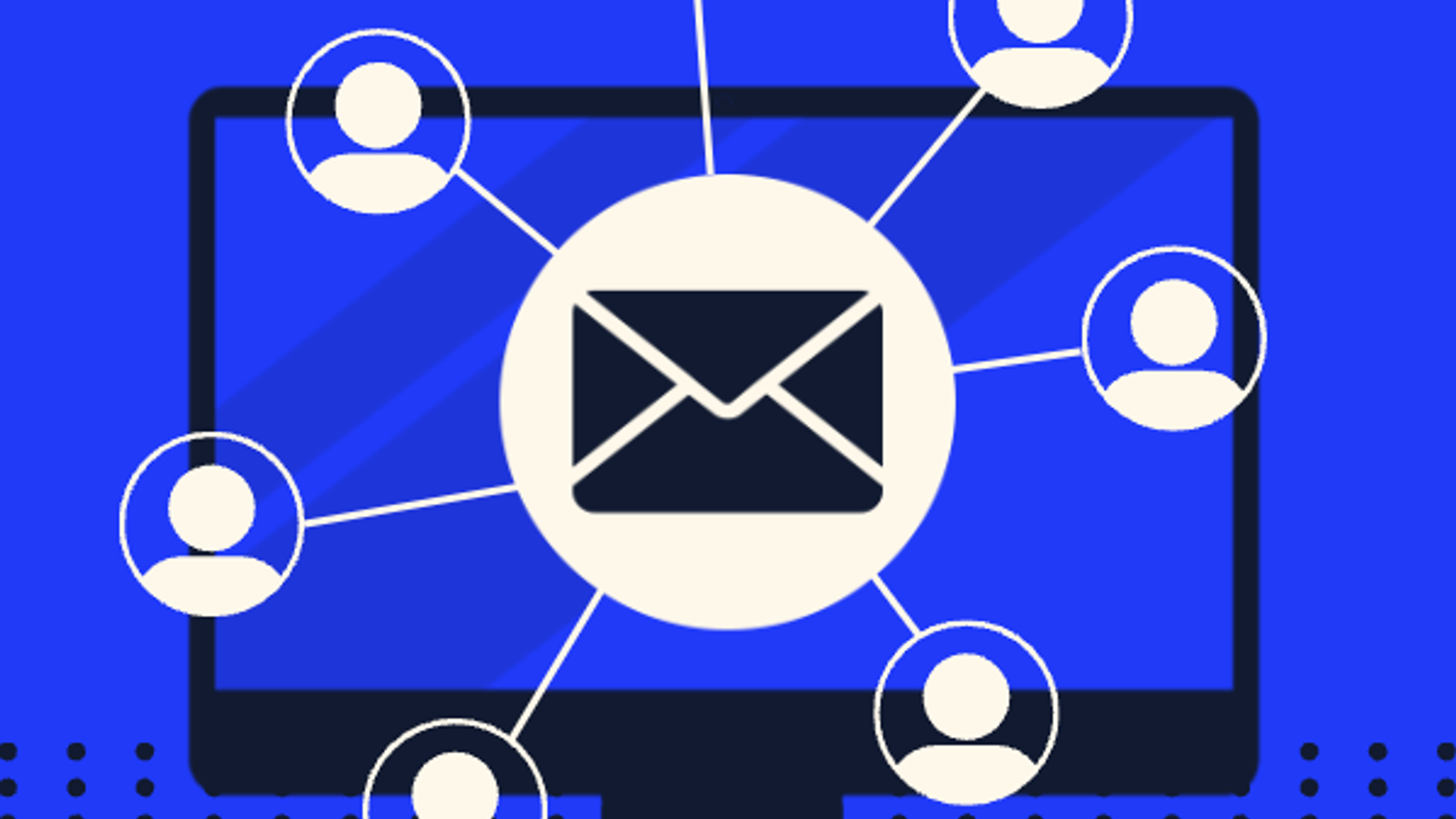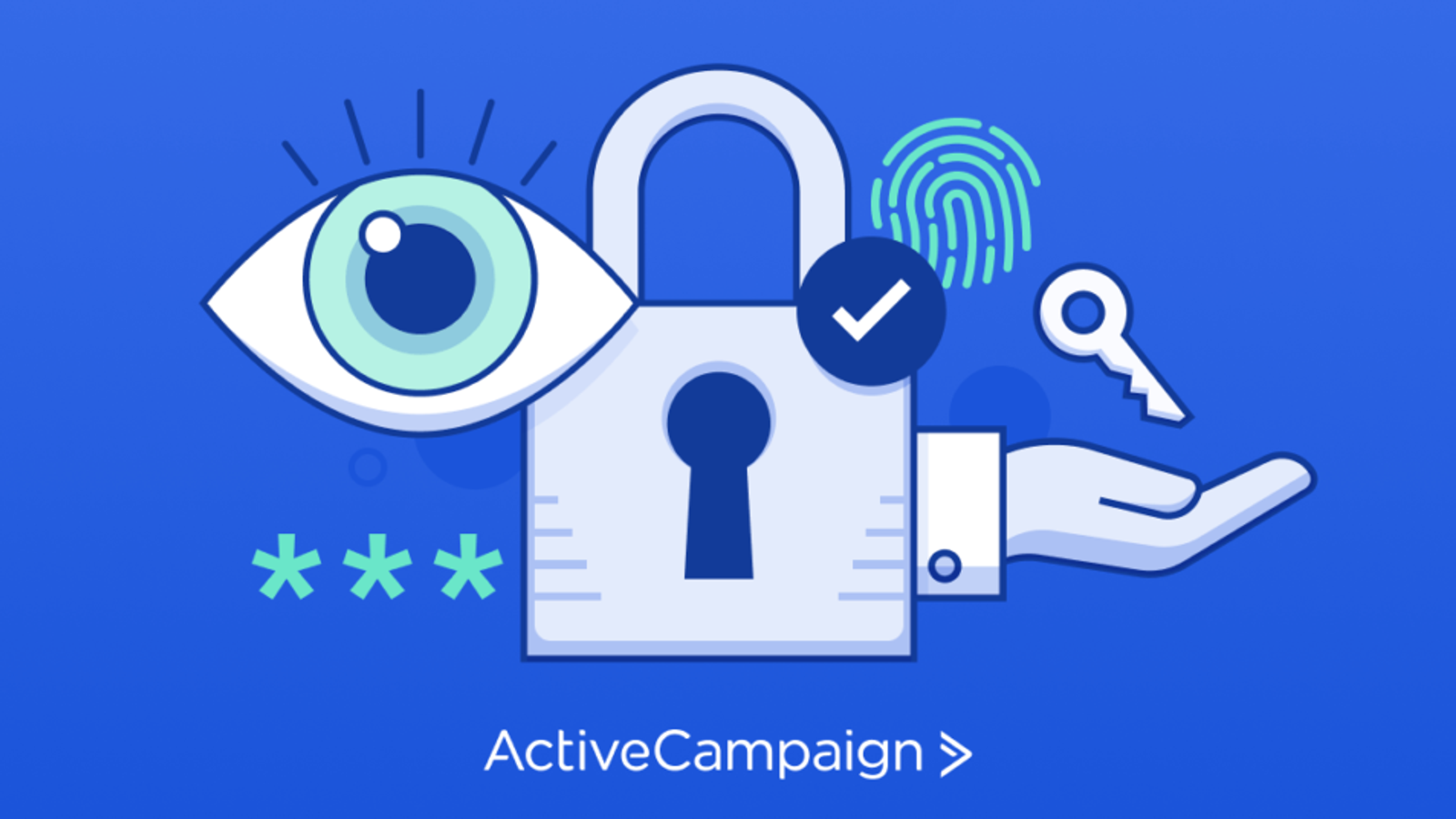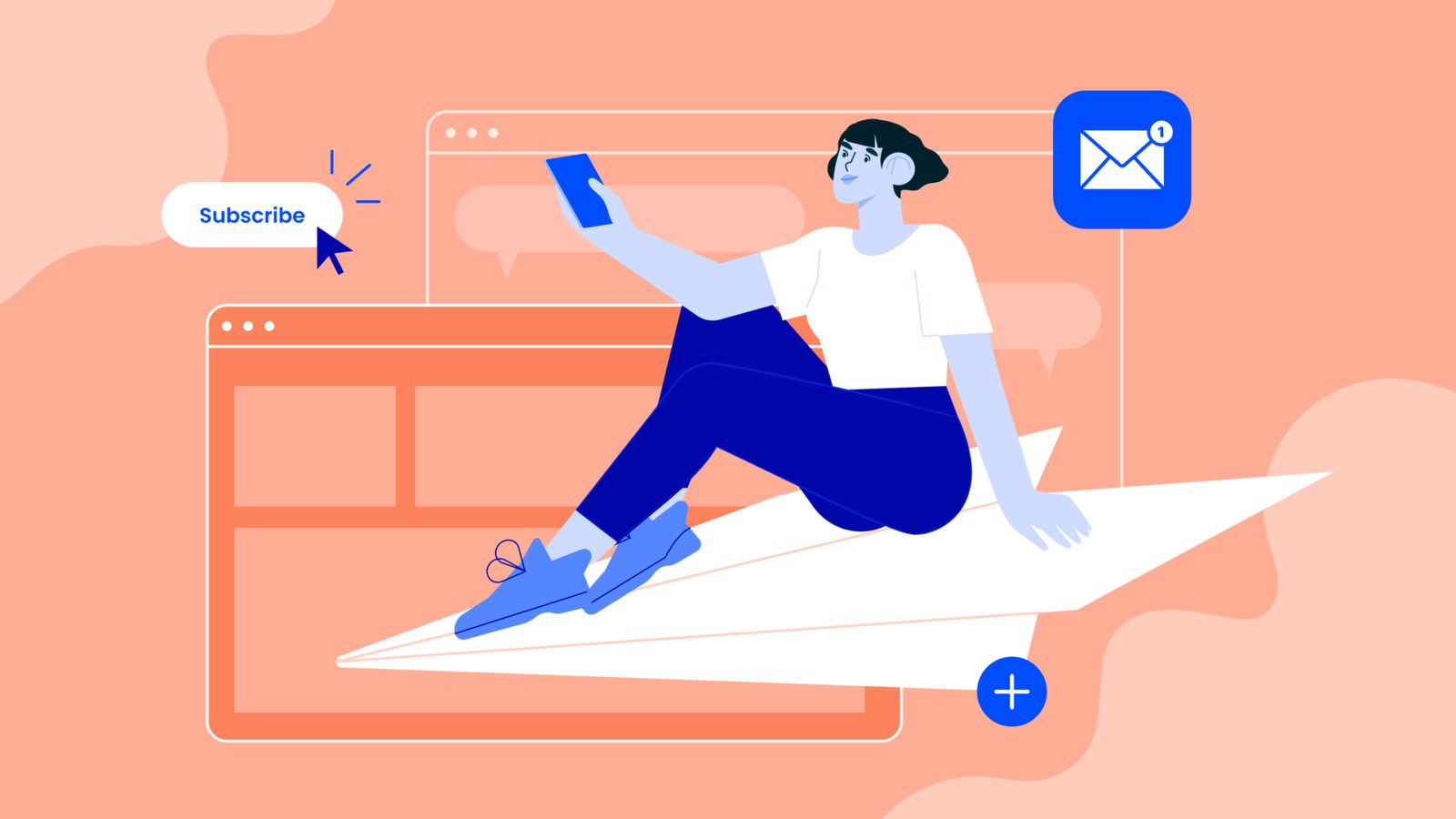Email remains one of the most effective ways to reach your audience. 61% of consumers enjoy getting promotional emails every week. But not everyone on your list needs the same kind of message. New subscribers might expect a welcome email, while longtime customers respond better to loyalty or milestone offers.
By sending the right type of email at the right time, you’ll nurture leads, increase conversions, and keep customers engaged. Below, we’ll explore 10 different types of emails you can use to stay relevant, spark interest, and drive real results.
Try it now, for free
Already using ActiveCampaign? Our Getting Started with Email Marketing Guide can get you up and running quickly.
Different types of emails
Here are the top 10 types of emails to send your customers:
- Newsletter emails
- Special offer emails
- Milestone emails
- Review request emails
- Welcome emails
- Curated content emails
- New product announcement emails
- Abandoned cart emails
- Progress emails
- Confirmation emails
1. Newsletter email
True or False: You should send a newsletter email.
True.
According to a survey by research firm Nielsen Norman Group, 90% of people prefer to receive company updates via email (10% prefer social media).
Newsletter emails help you:
- Build a relationship with customers
- Inform customers of company and industry news
- Reinforce your brand’s reputation
- Increase visibility for the brand and its products
- Send out your latest content (like a blog newsletter)
Here’s what a great newsletter looks like, courtesy of Fitbit.

Biggest takeaway
- The newsletter gives extra lifetime value beyond the product itself.
This monthly newsletter gives you content that targets the things you would use a FitBit to help with:
- Feeling good
- Eating well
- Hitting your fitness goals
All of this supports a core message – you know FitBit has products to track your health. Only at the end of the email is there a direct mention of the product.
The content of this newsletter isn’t telling FitBit subscribers “love our brand.” It’s telling them “Here’s how to love yourself.” And it ends with a CTA helping them get what they need to do it.
Read more on:
2. Special offer emails
Offer emails (also called promotional emails) include discounts, coupons, or other special deals that VIP subscribers get as a “thank you”.
I’m a fan of comfortable shoes that last for years, something the classic brand Keds knows well. Here’s an example of an email they sent exclusively to customers like me.
This is the subject line:

Oooh, a secret? Tell me everything.
This is the email content:

Biggest takeaway:
- Targeting the idea of exclusivity
Not to “discount” the discount (because of course we all love getting those), but the biggest takeaway from this offer email is the targeting.
One of Robert Cialdini’s persuasion techniques is scarcity, which means making things exclusive or only available for a limited time. It’s a natural reaction to think that something is worth having because only so many people can actually get it.
Making an offer exclusively available to VIP customers makes it infinitely more appealing (and you’d better believe I bought some shoes).
The goal of these promotional emails is simple – promote something. Even simpler – sell something.
You can make your promotional emails more effective by:
- Using exactly one email call to action
- Creating a mouthwatering email subject line
- Segmenting what you send to existing customers
- Making sure you keep your email deliverability high
- Optimizing the little things – like your email from name and preheader text
3. Milestone emails
A milestone email that celebrates a victory can help your readers feel special.
The Skimm is a current events newsletter aimed at millennial women. See what makes their 5-year milestone thank-you email a success.

Biggest takeaway:
- They are specific about what they are thankful for
The Skimm is thankful for your help reaching this milestone, but they don’t just say it – they show it.
Anyone can give a blanket thank-you in a milestone email, but The Skimm takes you on a journey to show you exactly how your subscription benefits you and them.
Plus, they use numbers. Numbers are concrete, indisputable proof that the time spent engaging with a brand was worth it. You put in the time, they noticed, and they are able to keep going because of subscribers like you.
4. Review request email
Research shows that 91% of people regularly or occasionally read online reviews – and 84% trust online reviews as much as a personal recommendation.
In other words, you must have reviews for your brand.
Asking for a review is the best way to get to know your audience. And the more you know them, the better you know what emails to send them.
Here’s what one really great review can accomplish:
- Confidence in your brand
- You learn about customer pain points
- You find out what product or service gaps you can fill
Additionally, 65% of customers report that online reviews significantly increase their trust when making a purchasing decision.
LOFT is a popular women’s clothing retailer (whose website I frequent regularly). The one thing I always do is check reviews for sizing caveats and other wearing experiences.
And they know just what to say in their review request to get that info for me. The following review request email example from LOFT is perfect from the subject line down to the content.

$1,000....that's not a typo??
Biggest takeaway:
- The subject line incentive – give a little, get a lot
I love this subject line for two reasons:
- What it’s offering
- How it offers it
I’m a frequent LOFT shopper (definitely more than I should be on a budget) and, of course, I want a chance to get some free money. But what’s even better about this is the copy offering it.
1,000 is a big number. It stands out and makes you look twice. This kind of copy is hard not to click on.
5. Welcome emails
Welcome emails are the cash cow of emails: on average, 320% more revenue is attributed to them on a per-email basis (over other promotional emails).
And you need them. This is not a debate.
Expert insight: Andy Crestodina on welcome emails

“There's one email that gets a higher open rate than all others: the welcome-to-my-list email.
It's no surprise. The recipient is at their peak interest. They just converted into a subscriber, so they are want your content and trust your brand. Setting this auto-response it a no-brainer. Opens and click through rates are often 2x any other emails you send.
Think of it as just being polite. When someone starts listening, you should say hello, right? When someone asks for more, give them your best. I think of the welcome series as both smart marketing and common courtesy.”
– Andy Crestodina is a marketing expert, thought leader, and co-founder of Orbit Media Studios. He's an expert in SEO, web design, and using data to guide marketing strategy.
Cool? Cool. Let’s dive straight into a killer example of a welcome email from Lyft.

Biggest takeaway:
- It’s clear from the content of the CTA
It’s really easy to turn a welcome email into a long ode of thankfulness that a customer is officially on the list. That may seem like a nice opener, but honestly? People who are new to your list don’t want an ode.
They want information.
Clear, immediately useful information about what you can do for them.
This Lyft welcome email example uses copy that leaves nothing up to interpretation. Their service is fast, trustworthy, and cost-effective. Bam. Done.
Plus an actionable CTA literally saying “Take a Ride” – this welcome email tells you everything you need to know to start using the service.
6. Curated content emails
Curated content is a collection of relevant, high-quality content.
It can mean a collection of content pieces related to one topic, or it can be curated info from other content used in a new content piece of your own.
Often it’s the first option, like this curated content email from Really Good Emails.
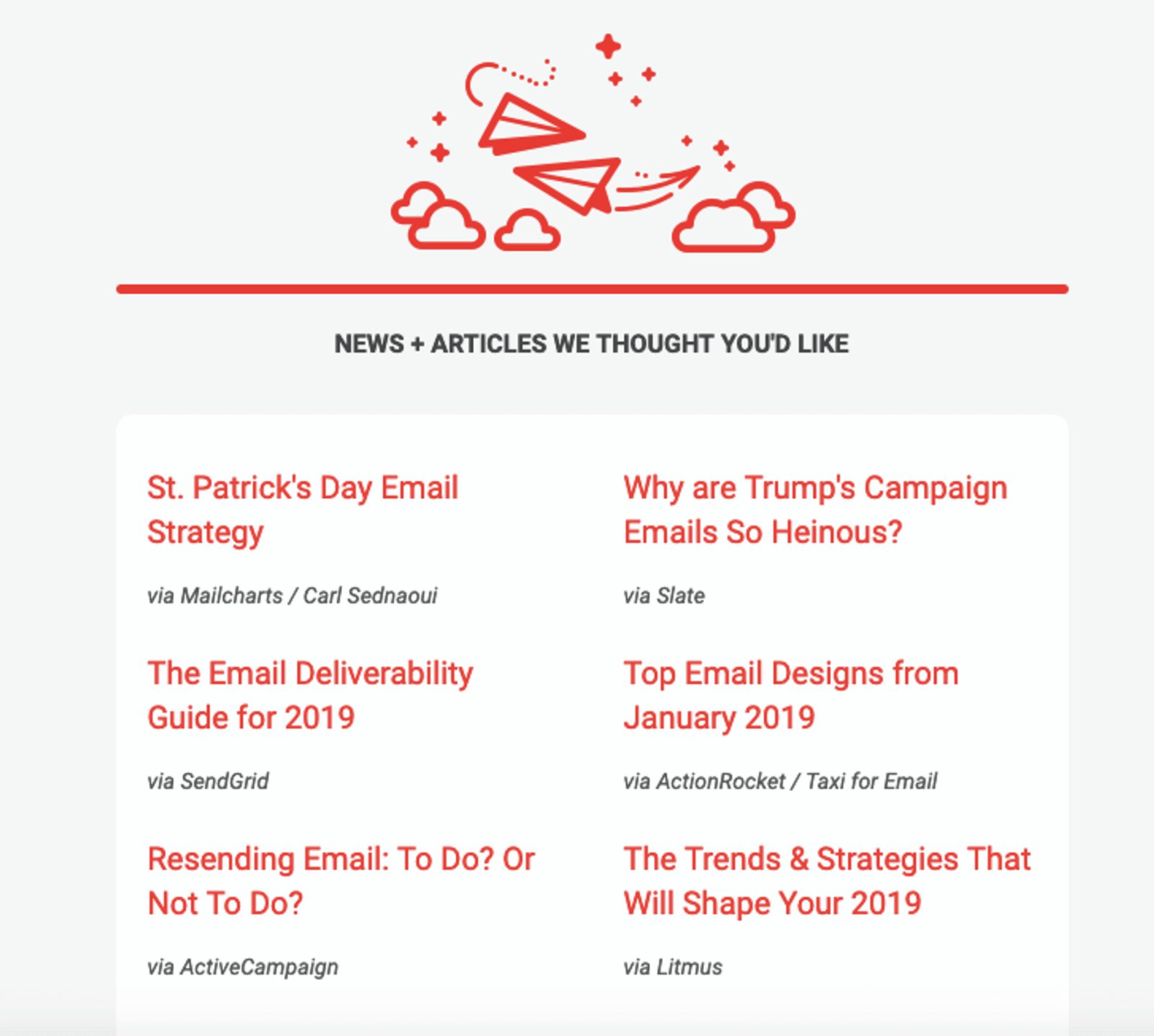
See any familiar names?
So how do you do content curation well? Pick a relevant topic, and then pick relevant content. Easy enough, right?
Neil Patel uses a checklist of questions to choose a focus topic and what content to put in a curated content email:
- Does my audience need to solve this problem?
- Is there enough data here to support further analysis and discussion?
- Do I trust this information and where it came from?
- If I expand on this content, will it strengthen my brand?
- Do I have a unique perspective that hasn’t been fully explored yet?
If the answer to all of these questions is yes, then you’re looking at a topic that’s worth covering.
Some ways to curate content are:
- Gather influencer advice on a topic
- Gather “best of the week” content from your industry
- Gather a collection of your best content pieces about the topic
Here’s an example of a curated content email from greeting card designer Postable.

Biggest takeaway:
- It’s a perfect storm of influencer expertise and relevant value (holiday card template downloads during the holiday season, cha-ching!)
In this email, there is:
- A collection of content from an expert in the field (greeting card designer Jill Ruzicka)
- Valuable content (holiday card template downloads for a holiday-timed email)
- A collection of relevant, funny links (showing industry awareness)
If you are a subscriber to a greeting card company email list during a high-volume holiday card time, what more could you want from a curated content email?
7. New product announcement emails
When you have a new product coming out, the first people to know should be on your email list. A product announcement email is step one.
Did you know that, according to the book Marketing Metrics, you can see 60-70% more conversion success selling to an existing customer (versus 5-20% success selling to a new one)?
The quickest way to boost sales is to sell to the people already buying from you.
Nokia “nose” (you’ll get it in a second) just how to hit the right notes of useful, funny, and clever in this new product email for the Nokia Home launch.

Biggest takeaway:
- A testimonial encourages a purchase decision
Huzzah for social proof!
In Robert Cialdini’s book, Influence: The Psychology of Persuasion, “we view a behavior as more correct in a given situation to the degree that we see others performing it.''
If someone else told you that a new product was worth your money, wouldn’t you feel better about trying it too?
(You know you would).
8. Abandoned cart emails
Research from Moosend shows that abandoned cart emails have an average open rate of 45% – and an average clickthrough rate of 21%. Half of those people make a purchase.
That means that a single abandoned cart email could convert 10% of the people getting it into customers.
Got it? Good.
Whisky Loot isn’t just reactive in their abandoned cart email –they’re proactive against every reason you might still try to defy your Whiskey Loot purchase destiny.
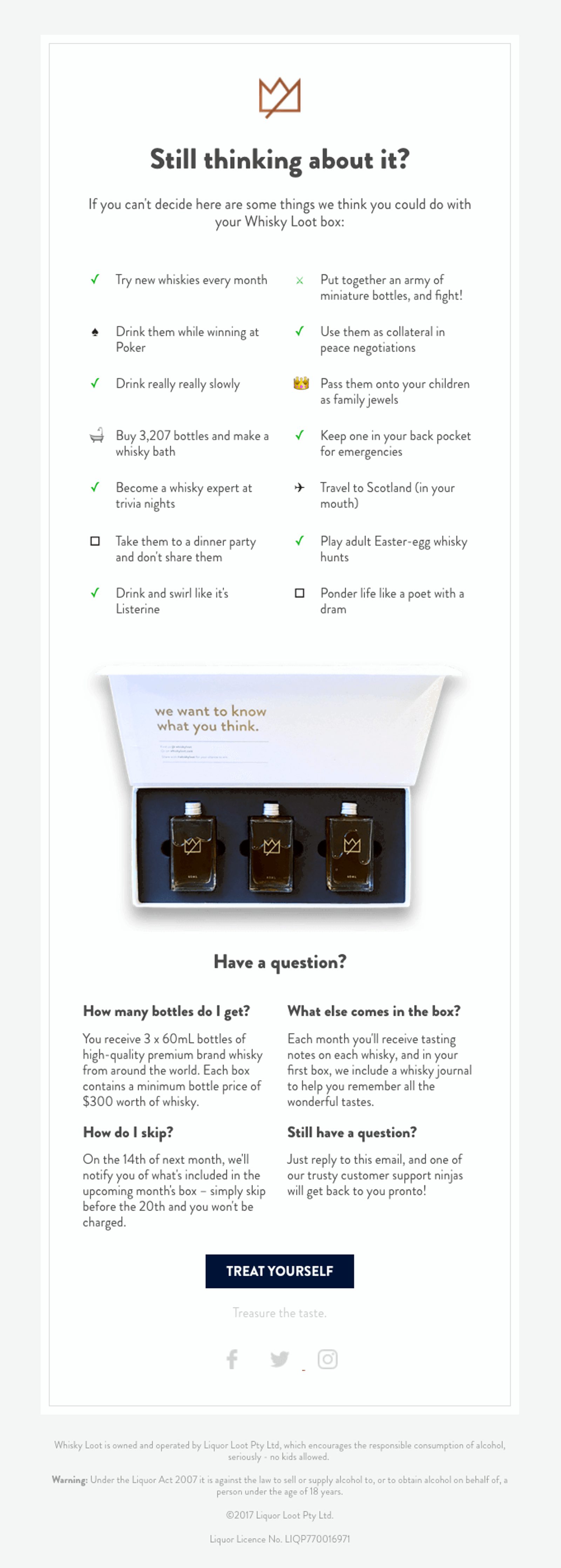
Biggest takeaway:
- Good luck finding a reason not to finish the purchase (they’ve covered it all)
It’s always easy to find a reason not to do something.
This abandoned cart email doesn’t just ask you to come back to your cart; it gives you 7 reasons why completing your purchase is a good thing (the cheapest trip to Scotland you’ll find anywhere).
And it doesn’t stop there.
If those 7 reasons aren’t enough to convince you, the email also addresses each question still holding you back.
9. Progress emails
Why do we get report cards, use scales during a weight loss challenge, or have annual reviews at work?
Because progress is a motivator.
Seeing proof that our actions have made a difference makes us want to keep going. It’s all well and good to keep pushing your customers through different stages of the product funnel, but how can they be sure that it’s worth it for them?
A regular progress email is one way you can show them.
TextExpander, a productivity software that creates typing shortcuts, has a good monthly progress email.
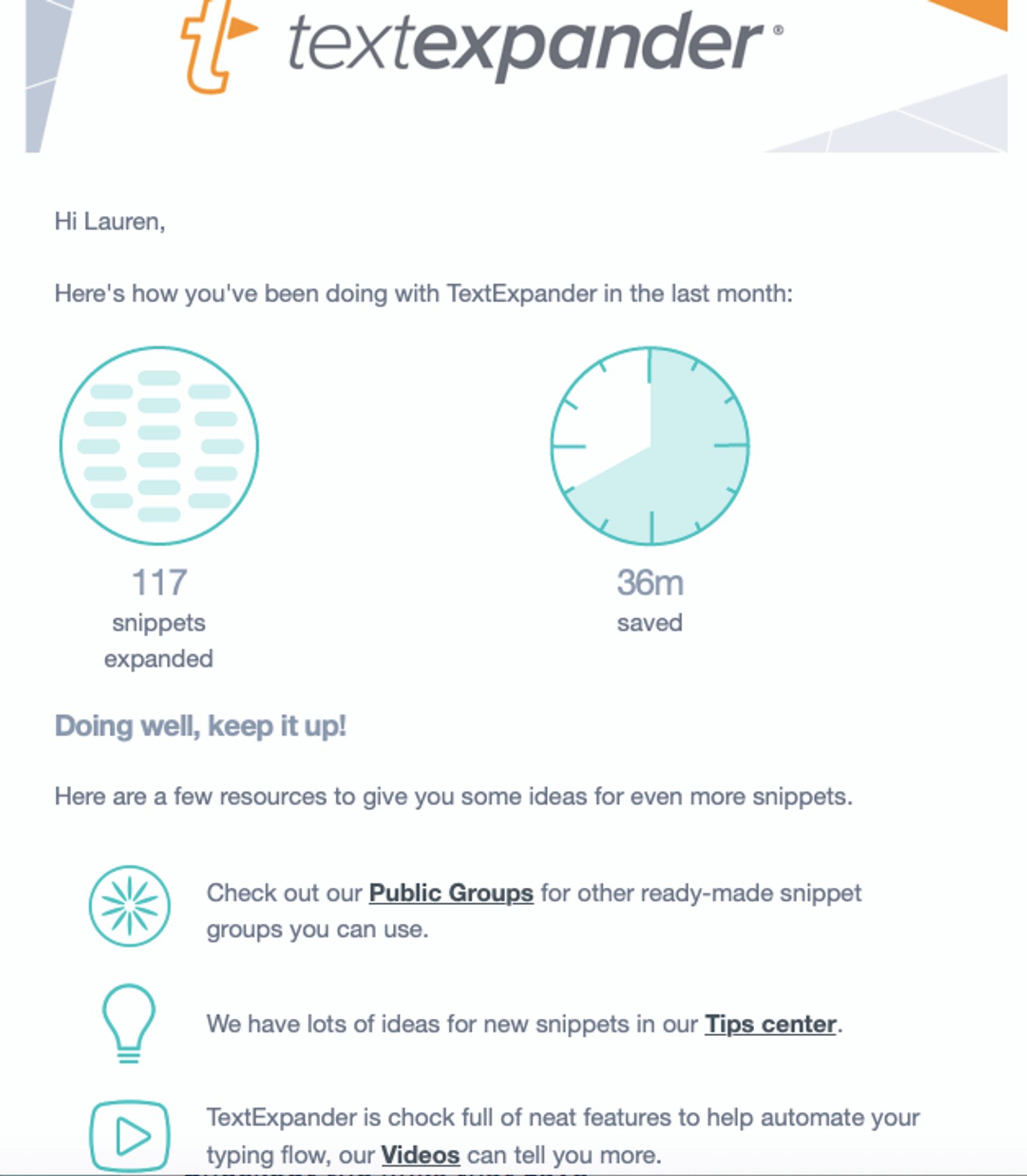
Biggest takeaway:
- It gives helpful resources to keep motivating your progress
Anyone who has ever tried to stick to a diet knows that it’s not easy. Eventually, a lot of people plateau, and it’s hard to keep motivated.
A 2013 study published in Translational Behavioral Medicine showed that participants who published their weight loss progress publicly lost more weight than those who kept it private.
This TextExpander progress email keeps you around by showing how far you’ve come – giving you what you need to keep going.
No doubt that you have a lot of useful content at your fingertips. Share it!
10. Confirmation emails
A confirmation email is a transactional email message you send to your website visitors and customers as proof of a completed action.
The three most common reasons for a confirmation email are:
- A list subscription confirmation email
- A purchase confirmation email
- A shipping confirmation email
Here’s a confirmation email example from Airbnb.

Biggest takeaway:
- It’s a smorgasbord of easy access to everything you need
What’s one thing that customers really hate? When you make things difficult.
Whether that’s finding information, going through a checkout process, or trying to get a human on the phone for support help, making it harder than it needs to be is a quick way to lose customers.
This kind of confirmation email avoids that. Here there is everything you need to:
- Review your payment
- Get fast support
- Confirm the little details
- Prepare for what to expect
Confirmation emails are one of many types of triggered emails that you can set to send automatically. Now you don’t have to worry – and neither do your customers.
A lot of businesses ignore these types of transaction emails – at their own peril!
That's dramatic, but also true. A confirmation email (and other transactional emails) is a great opportunity because...
- The email open rate is high – people are expecting the email because they just bought something from you
- Most transactional emails are boring, so you have a great opportunity to stand out
- People who get transactional emails are your existing customers. This means you already know they want to buy from you!
Hey, maybe even automatically send yourself a confirmation email to confirm that your other confirmation emails went out? No that’s too much... (or is it...).
Why do you need different types of emails?
A balance between value emails and promotional emails can be hard to get right. How do you know what to send (and when?)
Enter audience segmentation.
- A brand new subscriber who signed up to get access to a content lead magnet is not looking for a hard sell in the first email (though if you do it right you can sell them later)
- A repeat customer is not going to want or need the hand-holding, introductory-style emails from your welcome series
Segmentation helps you understand what people want—and give it to them.
Platinum Skin Care, an ActiveCampaign customer, converted 17% of their leads into paid customers using audience segmentation. Automatically. How nice is that?
Use segmentation when:
- You offer multiple products that serve different audiences
- You offer multiple products that serve different needs of the same audience
- You offer the same product, but it serves multiple audiences
There are a lot of reasons to use segmentation, but here’s what it comes down to – segment your audience if it contains multiple groups of people who care about different things.
How many marketing emails are too many?
A survey by MarketingSherpa showed “at least monthly” and “at least weekly” as the most popular answers to how often people want to hear from brands. Truthfully, it will depend on what email campaigns you choose to send.
Another survey done by TechnologyAdvice asked 472 U.S. adults this question:
“For what reasons have you marked a business’ emails as spam?”
Nearly 46% cited getting too many emails as their top reason. But I’ll let you in on a secret – Sending frequency isn’t what you need to worry about. Or at least, it isn’t the main thing.

Customers want promotional emails, but they don’t want a million emails with content that doesn’t matter to them. That same study found that nearly 32% cited irrelevant content as their spam-marking reason.
The last thing you want is more unsubscribes, so when you consider what types of emails to send (and how frequently), think about this:
- What’s most important to your customers?
- What’s most important for your business?
The quality of the email will always be a priority over how often you are sending them. Send emails that your email list will want.
Here’s one example from Perfect Keto to show you what I mean.
One of the most challenging parts of the Keto diet is learning how to eat out or on-the-go – because it’s not as easy as grabbing a granola bar or ordering a salad.
That’s why when you’d just have to click on this kind of email. The subject line and preheader text worked together to earn my click.

One keto blogger sends me a TON of emails and truthfully? The volume can get a little annoying at times.
But I open nearly all of them because:
- The subject lines are things I can’t help but click on – they address questions and concerns I have about Keto
- The email content matches the subject lines (zero clickbait)
- Over time, he’s proven that his emails are worth opening
This message addresses multiple pain points:
- Staying committed is hard
- Finding grab-and-go foods is hard
- Wishing it were easier to do
The rest of the email offers a targeted solution to those problems: travel keto snacks to take on the go.
This is just one of many emails like this that I get from Perfect Keto, but the content hits the nail on the head every time.
As long as you send emails that do the same (and you aren’t emailing people 4 times a day on the regular), your customers will love getting these 10 different types of emails from you.
Quality over quantity
It’s not how many emails you send—it’s how relevant they are.
As long as your messages address real needs and interests (like Perfect Keto’s targeted on-the-go snack tips), your subscribers will keep opening them.
With ActiveCampaign’s automation and segmentation features, you can deliver content tailored to each contact’s specific challenges, goals, or behaviors—ensuring that every email you send feels both timely and valuable.

By focusing on relevance rather than pure frequency, you’ll cultivate a loyal, engaged audience that’s always ready to open your next message.
Email types FAQs
Looking for additional clarity on choosing the right emails—or the right platform? Here are some quick answers to commonly asked questions.
What’s the difference between a drip email series and a newsletter?
A drip series is a sequence of emails sent automatically over time or triggered by subscriber actions—often focused on nurturing leads or guiding subscribers through a sales funnel. A newsletter, on the other hand, is usually sent on a regular schedule to share updates, news, or curated content with your audience.
Which email type yields the highest ROI?
It depends on your goals. Abandoned cart emails often see strong returns in e-commerce, while welcome series can drive high engagement and brand loyalty. Evaluate open, click, and conversion rates for each email type in your own campaigns to see which resonates most with your audience.
How do I pick the best email service provider for my team?
Focus on the features that matter most to your goals—like automation, segmentation, and analytics. Look for ease of use, strong deliverability, and reliable customer support. Free trials or demos can also help you see if the platform truly fits your workflow.
What’s the difference between a newsletter and a promotional email?
A newsletter typically shares valuable content like updates, tips, or company news to keep subscribers engaged over time.
A promotional email is more sales-focused, highlighting discounts, new product launches, or limited-time offers to drive immediate action.





